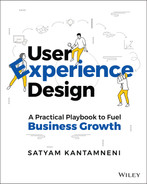CHAPTER 21
HIRING PLAY: How do I hire Experience Practitioners?
Hiring experience practitioners is a critical step in transforming your organization. However, many companies focus too much on tools and technical proficiency rather than on the mindsets and problem‐solving skills of their prospective employees. This play serves as a guide to help you hire the experience practitioners that you need to fuel business growth.
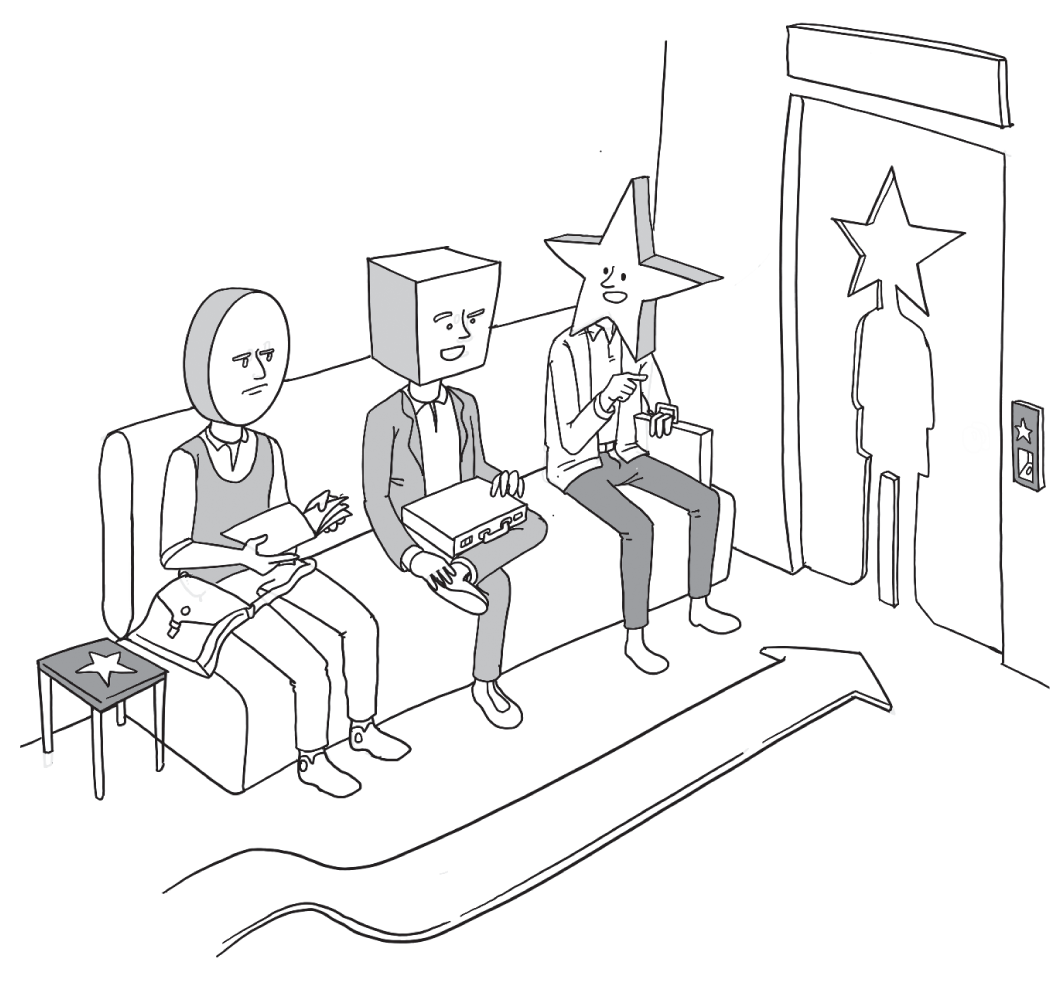
Who are the key players in the hiring play?
| ROLE | WHO’S INVOLVED | RESPONSIBILITIES |
|---|---|---|
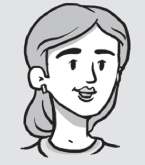 DRIVER |
|
|
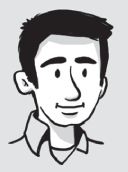 CONTRIBUTOR |
|
|
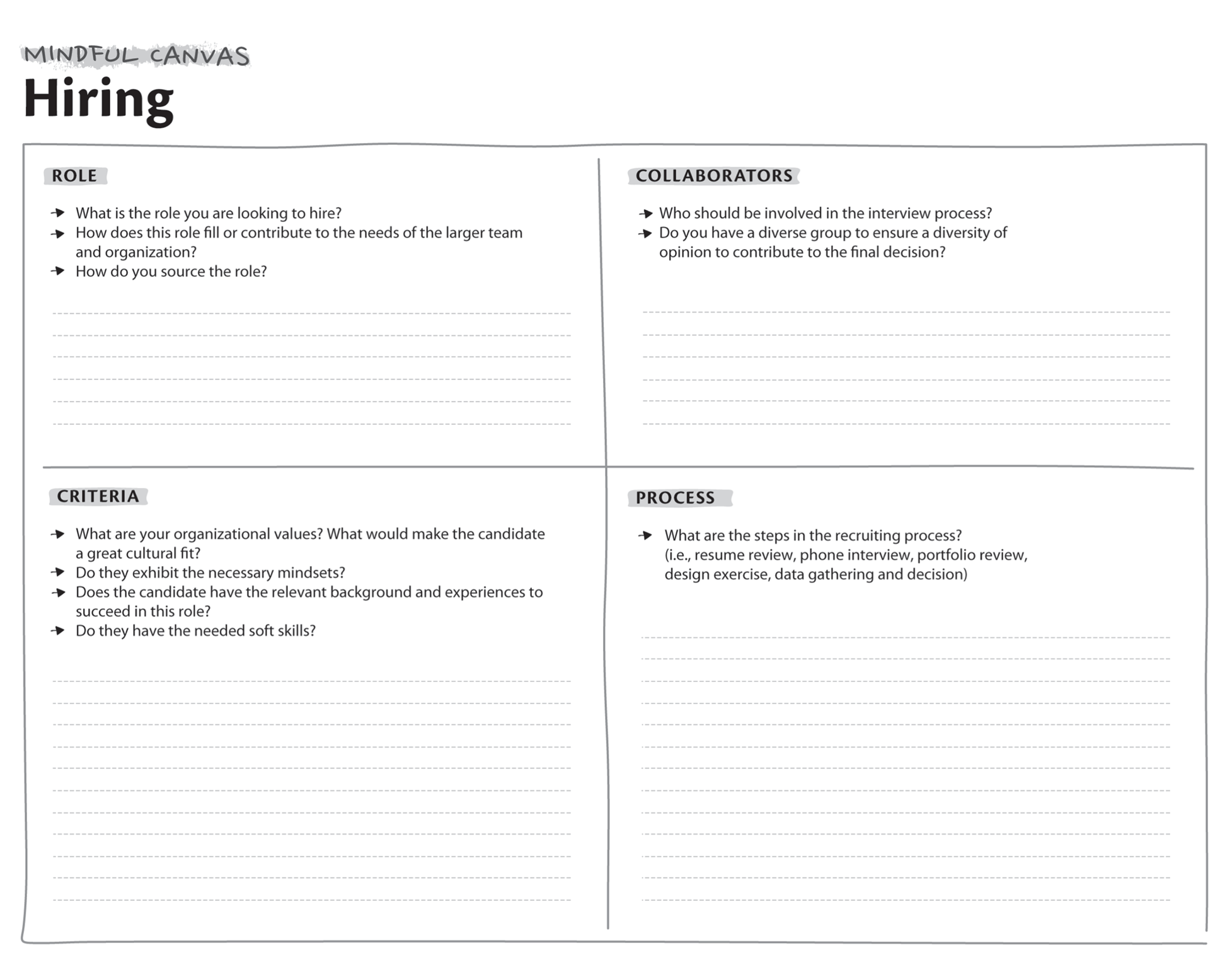
THE HOW
To run an effective hiring play, you need to be mindful of:
1. The ROLE
In addition to chief experience officer, there are five roles that make up the experience practice: experience strategist, user experience researcher, interaction experience designer, visual experience designer, and content experience designer.
Prioritize the roles based on the maturity of your organization, with the eventual goal of building the full practice with individuals who possess specialized skills.
Remember that hiring good experience practitioners is not an easy job. As the organization matures, be more flexible with hiring on both extremes of the experience range to ensure sustainability.
Once you have defined the role, go to the places where great talent is most likely to reside. For junior practitioners, go to colleges with design and innovation programs or clubs. Get referrals from company employees, or look for individuals who are at or have worked for organizations known for experience‐centricity.
2. Involving the Right Internal COLLABORATORS to Conduct Interviews and Evaluate Candidates
Given that the whole UX design practice is highly collaborative, involve the relevant internal collaborators to help you make the right hiring decisions. It’s best to have a diverse group of interviewers across seniority, backgrounds, and expertise to be able to come to the decision table with different insights, observations, and perspectives. At a minimum, involve stakeholders from the products and engineering team because these are teams who will most closely collaborate with the experience designer (Chapter 10: “Getting the Right People Right”).
3. Building a Multifaceted Hiring CRITERIA
Define the list of criteria that would make you want to extend an offer of employment. Depending on the specifics of the role, you may want to add a few more categories or choose to overweight certain categories over others. However, your standard list of hiring criteria for all experience practitioners and leaders should include the following:
- Cultural Fit: The candidate will not thrive if their own values are misaligned with those of the organization. Each teammate in the organization plays a key role in building and reinforcing the organizational culture. Therefore, throughout the interview they must demonstrate a fit to the organization’s value system and a proven ability to exhibit the cultural pillars of experience design: empathy, collaboration, ideation, experimentation, and iteration. (Chapter 16: “Culture Design Play”). For example, a candidate might demonstrate empathy by grounding their designs in user insights.
- Mindset Alignment: Mindsets are indicators of how likely the candidate will thrive in the organization over the long term. There are five mindsets we recommend organizations look for during its interview process: design, experience, systems, business, and outcome. (Chapter 10: “Getting the Right People Right”). After the interview process, assess mindset alignment by asking the following questions: Can the candidate think about the bigger picture? Can they demonstrate problem‐solving prowess? Can they think about the larger system and the interconnections around a particular problem? How interested are they in continuously growing and learning? To evaluate an outcome mindset, ask the candidate, “Tell me about a time when you delivered an impact for your team.” From their response, you can assess their understanding of impact and the tangible outcome they drove.
- Technical Fit: Does the candidate have the relevant background and experiences to succeed in this role? Have they demonstrated their ability to execute quality design? If they are a lateral hire or a career switcher, what experiences are transferable that would indicate they will more likely succeed? At UXReactor, all experience designers interact and closely collaborate with the client on a daily basis. Therefore, we value candidates who have had prior client‐facing roles (e.g. sales, business development, consulting) because we know they will be more likely to thrive at our company.
- Soft Skills: An experience practitioner needs to be able to communicate their designs to non‐designers, collaborate, and be proactive in reaching across the organization to bridge organizational silos. They need to care for the user, the larger business, and themselves to continuously learn in this growing profession. They also need to have an ownership mentality and take on responsibilities to deliver the best experience for the user.
Five Differentiators of an Awesome Practitioner vs. Mediocre Practitioner
4. Develop an Experience‐Specific Recruiting PROCESS
Now that you know the criteria, develop a hiring process that is customized for experience practitioners, using the following components:
- Resume Review: Resume review is an internal step designed to find technical fit by examining candidates’ prior background and experiences. The key question to answer is: How likely will this candidate succeed in this role?
- Phone Interview: The phone interview is your first real‐time interaction with the candidate. The goal at this stage is to assess cultural fit and their level of motivation for joining your team. Treat the phone interview as a conversation you are having with the candidate. A good cultural fit is also one that adds diversity of thoughts, background, and perspective to enrich the team. Provide opportunities to learn more about the person beyond their professional background.
At UXReactor, this is the time we “scare” candidates by being candid about all the potential challenges they may face if they were to join the firm. Be upfront and make sure it’s a mutual fit early on.
- Portfolio Review: A portfolio review gives the candidate an opportunity to present their best work and an opportunity for the organization to evaluate the breadth and depth of the candidate’s design experience. Though every portfolio is different, the portfolio review gives the organization insights into the candidate’s design philosophy, their previous impact, and their communication skills. Assess their ability to articulate the following:
- What was the problem? (Provide context.)
- Why was it important? (Explain the relevance of this problem.)
- How did they go about solving it? (Discuss process.)
- How do they know they solved it? (Share results.)
- Design Exercise: A design exercise allows the interviewer to assess the quality of the candidate’s work, the soundness of their thought process, and how well they speak about and rationalize their design. Typically, a design exercise is provided after the portfolio review and is centered on a design problem. The design problems themselves can run the gamut from the fantastic (“How would you design a time machine?”) to the very specific (“How would you design the checkout flow for ABC company?”). Furthermore, a few defined constraints, such as time and scope, typically accompany the design problem. The key qualities to assess are how well they understood the problem, stated their assumptions, navigated ambiguity, structured their thought process, communicated their design, and engaged the interviewers.
- Data Gathering and Decision
The hiring process can span weeks and involves a number of different stakeholders across the organization. It’s critical to have a process in place to collect and consolidate all of the inputs throughout the stages of the interview process in a timely manner. Furthermore, data should be collected on an individual basis and in confidence to avoid biasing other interviews and the hiring decision.
IN ORDER TO MAXIMIZE THE VALUE OF THIS PLAY
- The candidate is a user in your system. Give them a great candidate experience by treating the interview as a two‐way dialogue, and make them feel valued and respected.
- Don’t place too much weight on technical background. Skills and knowledge can be taught, but attitude and mindsets cannot.
- Have a diverse group of interviewers across backgrounds, experiences, and departments for a more well‐rounded evaluation of the candidate.
- Reflect on and continue to evolve your process. It’ll only get better over time.
- It takes approximately six to nine months for an experience practitioner to be fully effective after they’ve been hired. This timeline can be expedited if onboarding activities have been designed to get them familiarized with the context around the user, business, and product in the first two months.
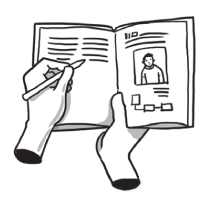 RELATED PLAYS
RELATED PLAYS
- Chapter 16: “Culture Design Play”
